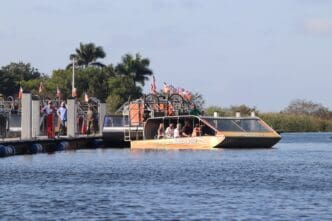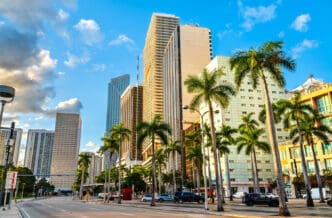The Vizcaya Museum and Gardens, formerly known as Villa Vizcaya, is the former mansion and estate of businessman James Deering, of the Deering McCormick-International Harvester fortune, on Biscayne Bay in what’s now the Coconut Grove neighborhood of Miami, Florida. The early 20th century Vizcaya estate also includes extensive Italian Renaissance gardens, native woodlands, and a historic village with outbuildings.
The Villa Vizcaya Museum and Gardens/James Deering Estate was designated a National Trust for Historic Preservation Landmark in 1994, a distinction bestowed on only a few sites in the United States. For this and many other reasons, this impressive museum is one of the best things you should see during your visit to Miami.

Built between 1914 and 1923, the Italian Renaissance and Roman Classicist mansion was designed by the New Yorkers F. Burrall Hoffman (architect) and Paul Chalfin (designer). The property also includes the original 1920 Miami Auto Supply Company factory building, founded by James Deering and his two business partners.
Because of the commercial success of their business partnership, James Deering was able to purchase the building in the early 1900s and convert it to a residence in 1916 after it had been remodeled and redesigned but not completed.
The property remained in the Deering family until 1952, when it was donated to Miami-Dade County. The Vizcaya became operational in 1953 as the Dade County Art Museum. After extensive renovation, the Vizcaya Villa opened as a museum showcasing the estate of James Deering.
In 1994, the Vizcaya property was designated a National Historic Landmark. This was a significant event in the property’s history and signaled its importance to the nation.
In 1998, in conjunction with Vizcaya’s reaccreditation by the American Alliance of Museums, the Vizcaya Museum and Gardens was established to manage the museum. This trust has helped preserve Vizcaya for future generations and ensure that the museum’s rich history and unique architecture can be enjoyed for years to come.
The museum attracts visitors from all over the country and the world who come to see the elegant residence and its gardens.
The Gardens of Villa Vizcaya

The gardens of Villa Vizcaya were designed by the Colombian Diego Suarez. Particularly noteworthy are the Mediterranean-style gardens, laid out in 1914. Originally intended to reflect the estate’s Spanish colonial past, the gardens were restored in 2007, the estate’s 80th anniversary. The estate’s other gardens include a cloud forest garden (with waterfalls), an English-style kitchen garden, a boxwood maze, and floral displays reflecting various regions of Spain and South America, from which James Deering sourced many of the seeds for his Biscayne plantation.
The Swimming Pool Grotto

The swimming pool at Villa Vizcaya was specially designed and built in 1916 and has three passages, the middle of which contains a raised deck through which swimmers can pass. The two side passages allow the water to flow in and out. Interestingly, the water of the swimming pool is changed every three to five years because minerals are deposited from the limestone rock that lines the reservoir.
Exhibits at Villa Vizcaya
While visiting the museum, visitors can admire a variety of exhibits. On the second floor of the residence, visitors will find The Power and The Glory: The World of James Deering and the Chicago, Michigan & Ohio Railway, featuring historical exhibits and photographs from James Deering’s corporate life, as well as original furniture from the Codwright dining car.
Also on the second floor is an exhibit dedicated to William Warder and Maude Schmidt, The Architects and Their Client: A Case Study-James Deering, which features drawings and photographs from the construction of Villa Vizcaya.
On the second floor is the exhibition The Interior Design: 1910-1940, with original furniture and decorative elements from the period. Exquisite lighting, designer wallpaper and ornate rugs are on display, as well as antique furniture imported from around the world. There are also some special occasion pop-up exhibitions that focus on women in architecture, horticulture and interior design.
Villa Vizcaya was built during the Great Depression to serve as a retreat for one of Chicago’s wealthiest industrialists. Soon after construction, the property was opened to the public as a museum to provide a glimpse into the life and times of James Deering.
Today, it remains an active museum and park with beautiful gardens, ornate architecture and Spanish colonial influences. We hope we were able to give you a little insight into this historic mansion and gardens!
Opening hours & Admission

Vizcaya is open to the public Wednesday through Monday from 9:30 a.m.; last admission is 4:30 p.m. The main house is open until 5:00 pm and the gardens until 5:30 pm. Vizcaya is closed on Tuesdays.
Admission:
Adult (13+) $25
Child (6-12) $10
Children (5 and under) Free
–
Written by Maria Paula Pacheco
Photos by Javier Valdez








